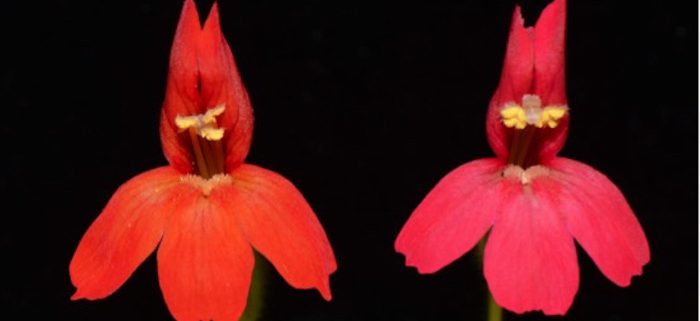Regulation of Carotenoid Pigmentation in Flowers
Stanley et al. Identify a protein in the model plant monkeyflower (Mimulus) required for chromoplast development and carotenoid biosynthesis. Plant Cell https://doi.org/10.1105/tpc.19.00755
By Lauren Stanley and Yao-Wu Yuan, University of Connecticut
Background: Carotenoids are yellow, orange, or red pigments that give many flowers and fruits their brilliant colors. In order to make and accumulate carotenoids in these organs, plants must (i) switch on the genes for carotenoid-producing enzymes and (ii) build specialized storage organelles called chromoplasts. However, very few regulatory genes controlling these two processes in flowers have been identified.
Question: We wanted to discover new regulators of carotenoid production and storage in flowers. We did this by chemically mutating the DNA of two species of Mimulus (monkeyflower) and searching for mutants lacking yellow pigmentation in their flowers. We sequenced the DNA of one mutant with a dramatic decrease in carotenoid accumulation to identify which gene was impaired and did experiments to characterize how this gene contributes to flower coloration.
Findings: We found a gene that we named Reduced Carotenoid Pigmentation2 (RCP2), because disruption of this gene causes Mimulus flowers to lose most of their carotenoids. rcp2 mutant plants cannot switch on carotenoid enzyme genes to the same degree as wild-type plants and do not make normal chromoplast storage organelles. When we engineered plants to make extra RCP2 proteins, the normally whitish floral reproductive organs turned yellow. Together, these results show that RCP2 is necessary and sufficient for carotenoid pigmentation in Mimulus flowers. Interestingly, although RCP2 by itself has no effect on carotenoid accumulation in leaves, simultaneously turning down the expression of RCP2 and two closely related genes (RCP2-like genes) resulted in pale leaves that were deficient in both carotenoid and chlorophyll pigments and with a smaller cell volume occupied by chloroplasts. This indicates that the original function of RCP2-like genes might have been to regulate essential chlorophyll and carotenoid pigments in vegetative tissues and that RCP2 has evolved specialized function in the regulation of carotenoid accumulation in reproductive organs for pollinator attraction.
Next steps: Moving forward, we want to learn more about the functional mechanism of RCP2 by identifying proteins that physically interact with RCP2 and to discover additional carotenoid regulators in the monkeyflower system by analyzing chemically induced mutants and natural variation.
Stanley, et al. (2020). A Tetratricopeptide Repeat Protein Regulates Carotenoid Biosynthesis and Chromoplast Development in Monkeyflower (Mimulus). Plant Cell: DOI: https://doi.org/10.1105/tpc.19.00755




